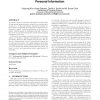ACL
2011
13 years 7 months ago
2011
Compositional question answering begins by mapping questions to logical forms, but training a semantic parser to perform this mapping typically requires the costly annotation of t...
OTM
2010
Springer
14 years 1 months ago
2010
Springer
Abstract. Folksonomies are becoming increasingly popular. They contain large amounts of data which can be mined and utilized for many tasks like visualization, browsing, informatio...
CIKM
2010
Springer
14 years 1 months ago
2010
Springer
A typical collection of personal information contains many documents and mentions many concepts (e.g., person names, events, etc.). In this environment, associative browsing betwe...
LOGCOM
2008
14 years 3 months ago
2008
We describe a two-layer architecture for supporting semantic interpretation and domain reasoning in dialogue systems. Building systems that support both semantic interpretation an...
COGSCI
2006
14 years 3 months ago
2006
Wepresentaset-theoreticmodelofthementalrepresentationofclassicallyquantifiedsentences(AllP are Q, Some P are Q, Some P are not Q,and No P are Q). We take inclusion, exclusion, and...
ACL
1998
14 years 4 months ago
1998
We introduce an algorithm for scope resolution in underspecified semantic representations. Scope preferences are suggested on the basis of semantic argument structure. The major n...
SIGLEX
1991
14 years 6 months ago
1991
The lexical entry for a word must contain all the information needed to construct a semantic representation for sentences that contain the word. Because of that requirement, the f...
DEXAW
2004
IEEE
14 years 7 months ago
2004
IEEE
In this paper I present a dynamic approach for constructing an unambiguous semantic representation for a text written in a controlled natural language called PENG. The semantic re...
ECAI
1994
Springer
14 years 7 months ago
1994
Springer
This paper presents a lexical model dedicated to the semantic representation and interpretation of individual words in unrestricted text, where sense discrimination is difficult t...
IFM
1999
Springer
14 years 7 months ago
1999
Springer
SOFL (Structured-Object-based-Formal Language) is recently proposed to combine the advantagesof formal methods, structured methods and object-oriented methodology into one method ...



